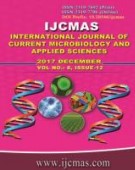


 National Academy of Agricultural Sciences (NAAS)
National Academy of Agricultural Sciences (NAAS)

|
PRINT ISSN : 2319-7692
Online ISSN : 2319-7706 Issues : 12 per year Publisher : Excellent Publishers Email : editorijcmas@gmail.com / submit@ijcmas.com Editor-in-chief: Dr.M.Prakash Index Copernicus ICV 2018: 95.39 NAAS RATING 2020: 5.38 |
Dermatophyte infections are common superficial fungal infections and are prevalent all over the world. Some dermatophytes are cosmopolitan in distribution, while others are geographically restricted. In an immunocompetent host, the lesions have typical appearance of being annular and scaly with central clearing. But, in patients with HIV/AIDS or any other immunosuppression, the lesions can be extensive and without central clearing. Recently, the Indian scenario has changed due to inadvertent use of topical steroids and we often come across atypical and extensive lesions without central clearing. Due to sudden rise in the incidence of tinea faciei for the past few years, a study was conducted in detail in the current clinical pattern and mode of transmission of tinea faciei and to isolate the dermatophyte associated with it. Patients with typical and atypical dermatophytic lesions and KOH and/or culture positive were included in the study. Samples were collected from the affected area after cleaning the part with 70% ethyl alcohol. Samples were planted on Sabouraud Dextrose Agar (SDA), supplemented with chloramphenicol and cycloheximide. The commonest clinical pattern of tine faciei in males was ill-defined scaly lesions without signs of inflammation 15(35.71%) and in females, erythematous plaques with pustules and without central clearing, was the commonest lesion 16(44.44%). None of the patient had any immunosuppression except few had diabetes mellitus. Out of a total 78 samples, 57 (73.07%) were Trichophyton interdigitale, one case (1.28%) was due to Trichophyton violaceum and no other species were found. Nearly 30% of the patients couldn’t recollect the name of the topical cream used by them. Molecular typing of the isolates was not done. Tinea faciei should be considered as a separate clinical entity. Some of the facial lesions can mimic other clinical conditions and we are coming across more cases of tinea faciei as compared to reported in the past. Awareness among the patients has to be created about taking appropriate treatment from the dermatologists; otherwise it may lead to an epidemic, difficult to control.
 |
 |
 |
 |
 |